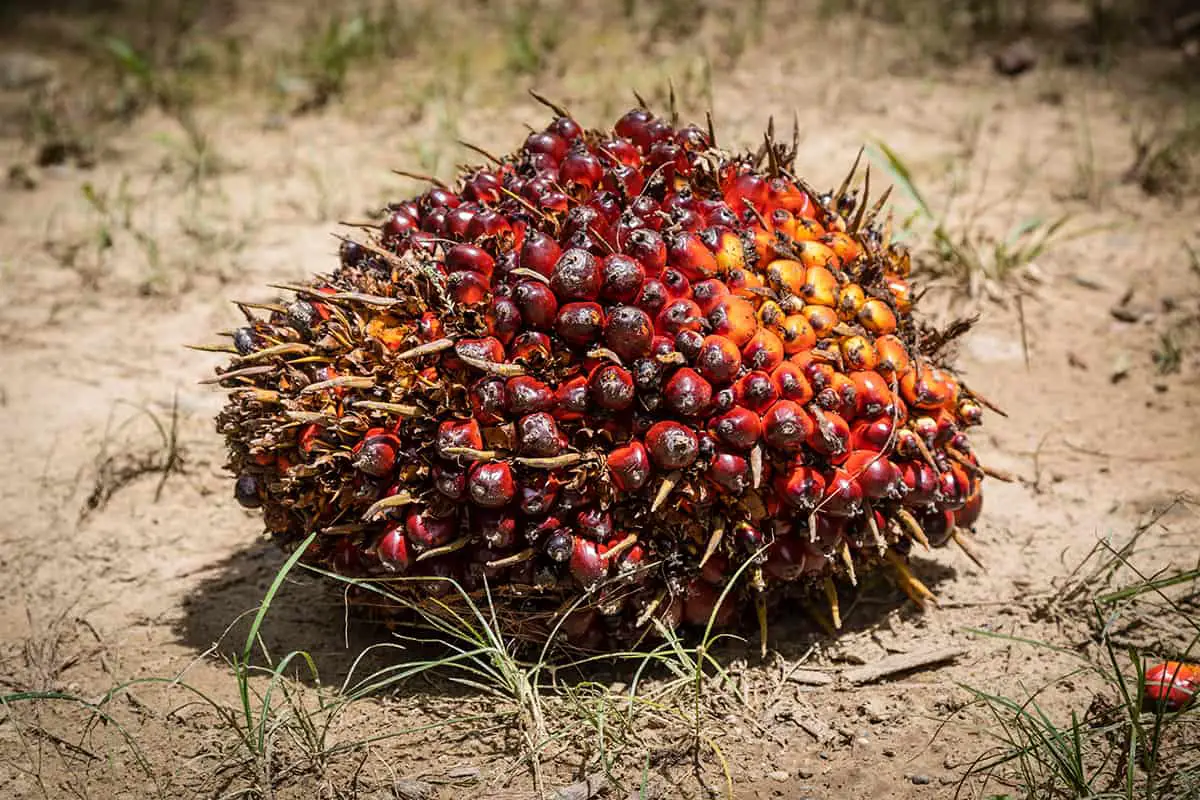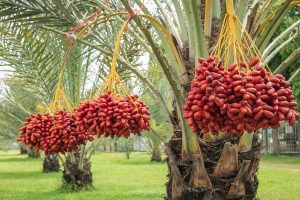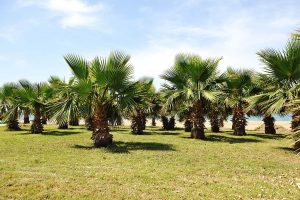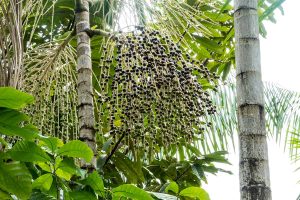Palm trees are most commonly associated with the production of coconuts and date fruits, but there are, in fact, over 2600 different species of palm, and each of these produces a different type of fruit.
If you are growing a palm tree, you may be wondering what type of fruit it is able to produce, whether the fruit is edible, and what you might be able to use it for. Here we look at some of the palm trees which are most commonly cultivated for their fruits.
Table of Contents
Coconuts
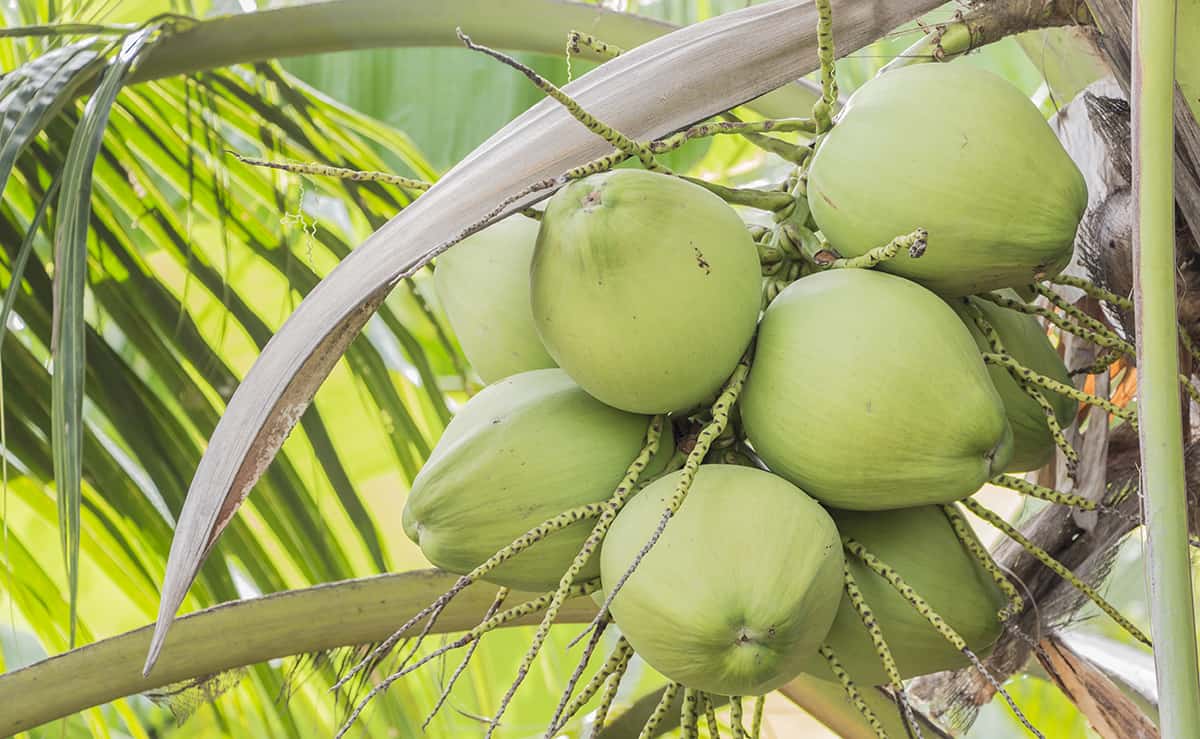
The most widely known fruit associated with palm trees is the coconut. When envisioning a palm tree in their mind, many people will imagine clusters of coconuts at the top of the tree, just beneath the fronds.
The differences between a palm tree and a coconut tree are that all coconut trees are types of palm trees, while not all palm trees are coconut trees. In fact, out of over 2600 species of palm trees that exist, only one species actually produces coconuts. This is the Coconut Palm tree, botanically known as Cocos nucifera.
Within the Coconut Palm species, there are many different varieties of Coconut Palms, which produce an array of different types of coconuts. The iconic coconut is a round fruit surrounded by light brown hairy fibers, with an inner white meaty flesh and sweet coconut water.
This is the ripe type of coconut that is commercially produced for eating, drinking, and cooking, but there are many other types of coconuts.
In the wild, most coconut fruits tend to be oblong shaped, and before they have ripened, they will have a yellow or green outer husk. Some coconuts have a lower sugar content which makes them best suited to use in health and beauty products, while the sweeter coconuts are ideal for desserts.
Coconut fruits are used in so many ways; for example, the meat can be eaten raw or cooked, it can be grated or shredded to use in baking, or it can be frozen and blended into smoothies. Coconut milk is commonly used in Asian cooking, while coconut water is a recent health craze that has taken off due to the nutrients contained in this drink.
Coconut water is marketed at athletes in particular, but it is a healthy drink to be consumed by anyone. It is high in potassium and contains reasonable levels of magnesium and calcium. Coconut oil, which is derived from coconut fruit, is also widely used in cooking and also in beauty products for its conditioning and moisturizing qualities.
Despite being known as a ‘nut’, the coconut is actually a drupe, similar to dates, olives, and cherries. They can measure as much as two feet in diameter and have a typical weight of 3 lbs.
Dates
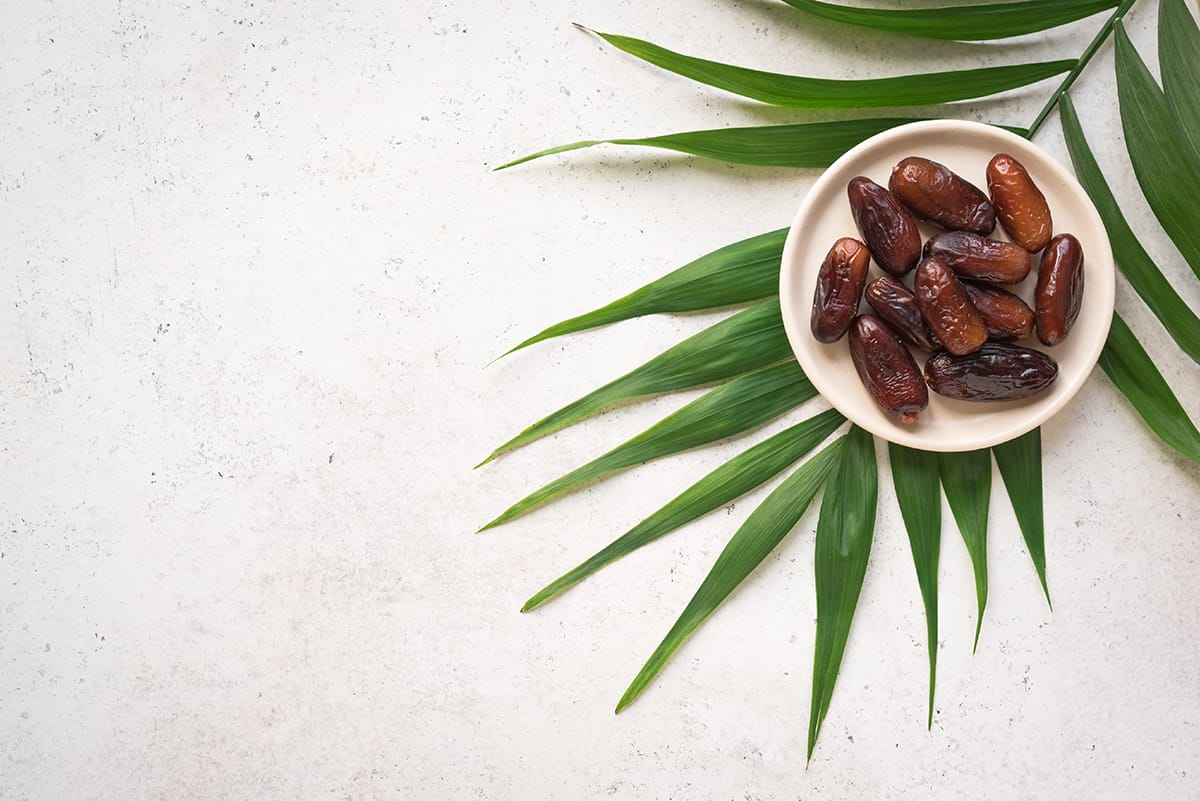
Dates are a type of drupe fruit, and they are known for their sweet taste and sticky texture. The dates that most of us will have eaten at some point in our lives will have been harvested from the Date Palm tree, botanically called Phoenix dactylifera. This tree can be traced back to Ancient Egypt, and it is now widely cultivated across the Middle East, Africa, and Asia.
The dates that the tree produces can be brown, red, or yellow and will be between 1 and 3 inches in length. Dates are known to be among the sweetest fruits in existence, with a sugar content of around 65% when dried.
Dates are consumed in many different ways. They can be eaten as snacks when soft or dry, and they are also commonly added to curries, tagines, and casseroles. Dates can also be used in desserts or glazed in syrup for a sweet treat. Pastes can also be made from ground dates, which take the shape of a spread similar to peanut butter.
Dates can also be stuffed with nuts such as almonds or wrapped in cured ham. Date juice is popular in Middle Eastern countries, and a sparkling date drink is used as an alcohol-free alternative in Islam.
The Date Palm tree is not the only palm tree that produces dates. Other species include the Canary Island Date palm (Phoenix canariensis), the Pygmy Date palm (Phoenix roebelenii), the Cretan Date palm (Phoenix theophrasti) and the Senegal Date palm (Phoenix reclinata).
The Senegal Date palm produces dates that are sweet and sticky, but they are smaller and harder than commercially produced dates. They also have less flesh and larger stones. Senegal Date palms are not cultivated for their fruits. However, they provide an important source of food to local animals, as well as human foragers.
The Pygmy Date palm produces clusters of small showy red fruits that look like berries and then turn black when ripe. The dates have a much lower sugar content than commercially produced dates you will find at the grocery store, and they are smaller with less flesh. They are not considered particularly tasty; however, they are edible.
The Canary Island Date palm also produces date fruits which are edible, but they lack the size and flavor of the dates grown on Date Palm trees.
Cretan Palm trees are another species of date palm that also produce date fruits that are not considered to be particularly appealing. These trees grow natively in Crete, the largest palm forest in Europe. The trees are not cultivated for their fruits, though they are edible and may be foraged for use by locals.
Acai Berry
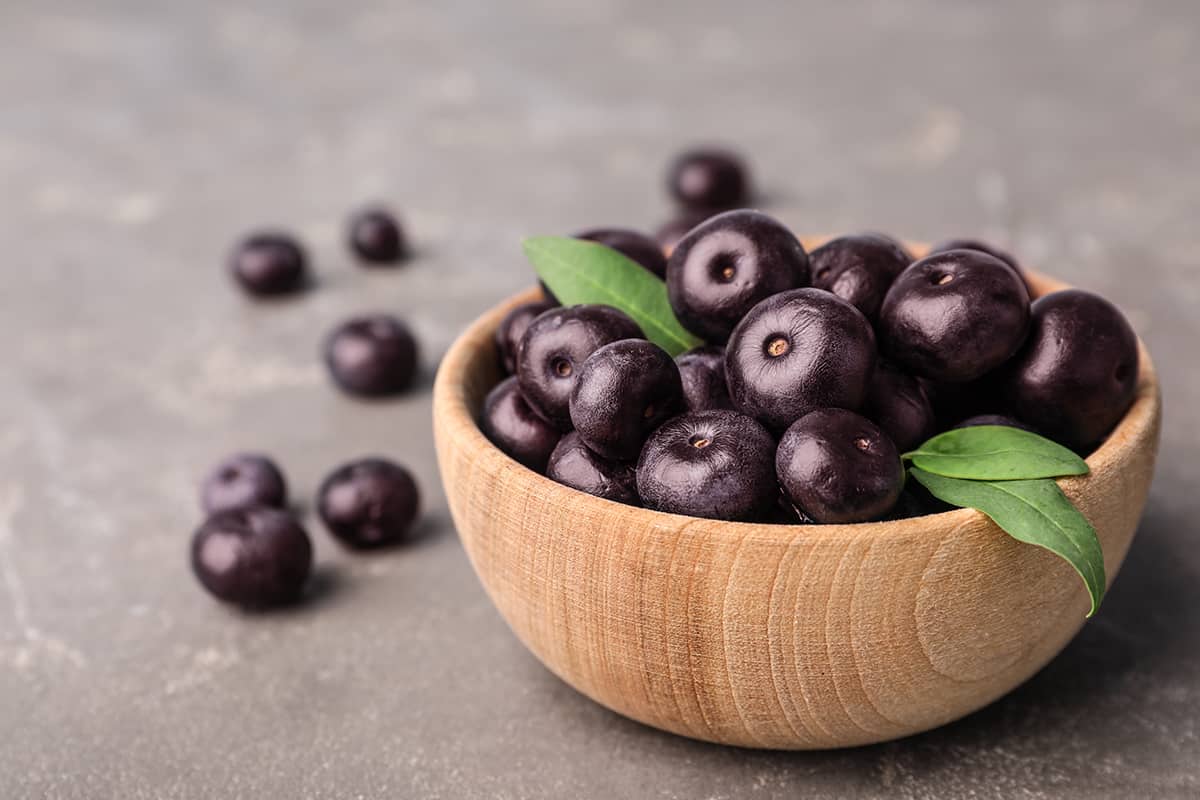
Acai berries are produced by the Acai Palm tree, botanically called Euterpe oleracea. These berries are, in fact, not true berries at all. Instead, they are a drupe like coconuts and dates. Acai berries are produced in dense clusters of up to 900 fruits on each branch. They start out a reddish-purple color and become almost black when ripe. As a fresh fruit, Acai berries are typically not found outside of South America, where the trees grow natively, because they have a short shelf life.
However, the fruits are widely sold around the world as dried snacks and as health supplements. In recent years, Acai berries have become known for their nutritional benefits, including antioxidant properties. The taste of Acai berries is said to be earthy, similar to the taste of blackberries. Each berry typically measures around 1 inch in diameter, but they have large seeds, which means that the flesh of the fruit is quite small.
Jelly Palm Fruit
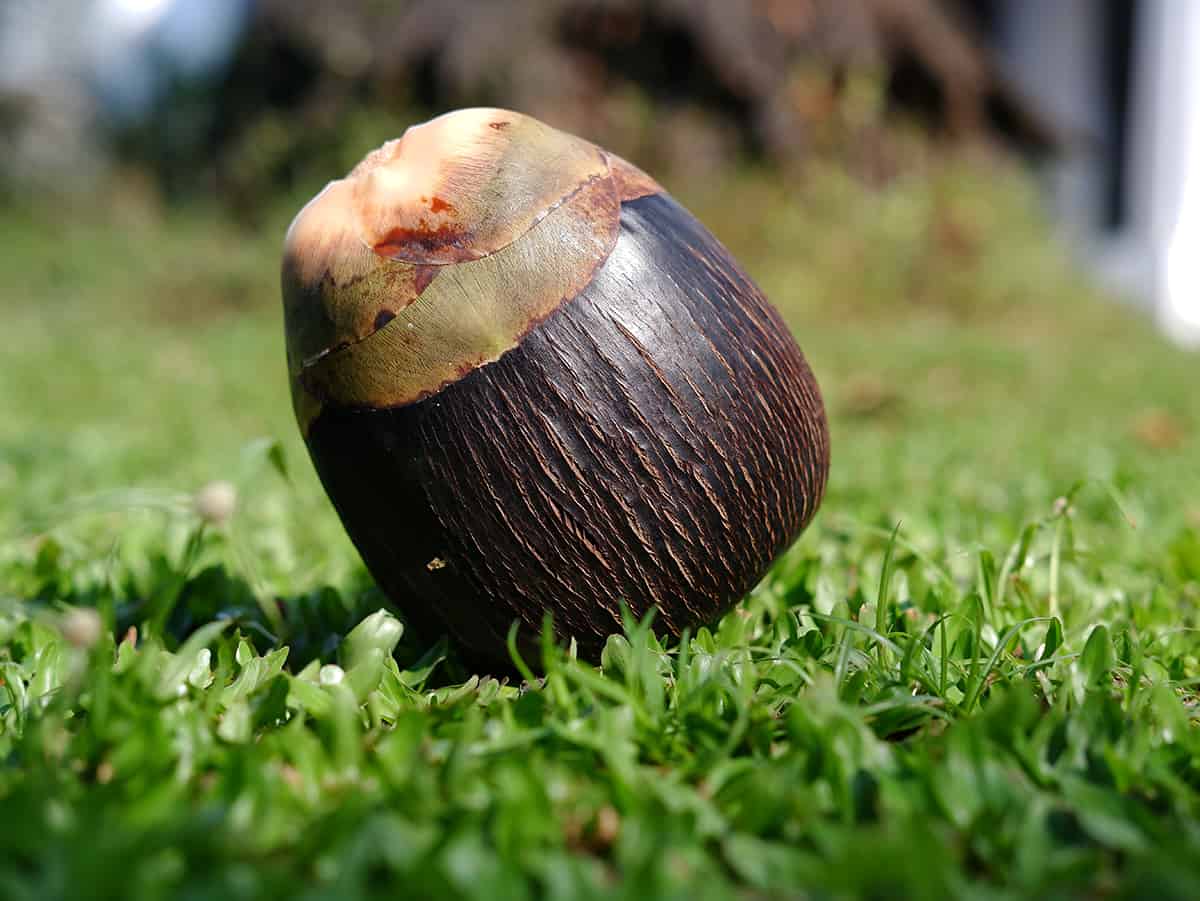
A fruit known as jelly palm fruit is produced by Butia capitata, known commonly as the Jelly Palm tree or the Pindo Palm tree. The tree is native to Brazil, with a thick trunk, feathery fronds, and a maximum height of 32 feet.
The fruits of the Jelly Palm tree take the shape of small orange berries, measuring approximately 1 inch in diameter when fully grown. They grow in huge clusters beneath the fronds of the palm tree and are harvested locally from wild trees in Brazil from November through to February.
Jelly palm fruits have a jelly-like inner flesh, which is where they get their name. The fruit has high pectin levels, which is what results in the moist jelly pulp. The inside of the fruit is bright orange in color, and it is particularly fibrous, with a slightly oily texture. In fact, the fruits can actually be used to make an oil, which is similar to coconut oil.
When eaten raw, the taste of these fruits resembles apricot or banana. Jelly palms can have a number of edible uses. They are used in the making of liquor, fruit juice, ice cream, and of course, jellies and marmalades. In Brazil, fruits are sometimes pulped and added to fruit juice in schools because of the nutrition contained in jelly palm fruits.
According to the National Academy of Medicine, a 100g serving of jelly palm will provide more than 40% of a child’s recommended amount of vitamin A. The fruits are also a good source of beta carotene.
Jelly Palm trees are widely grown in Florida, where they are better known as Pindo Palms. They are a popular ornamental plant in the landscape, but they can become messy to keep because of their fruit. After the fruits ripen, they will fall to the ground, and their jelly-like texture can make quite a considerable mess on the floor.
Saw Palmetto Fruits
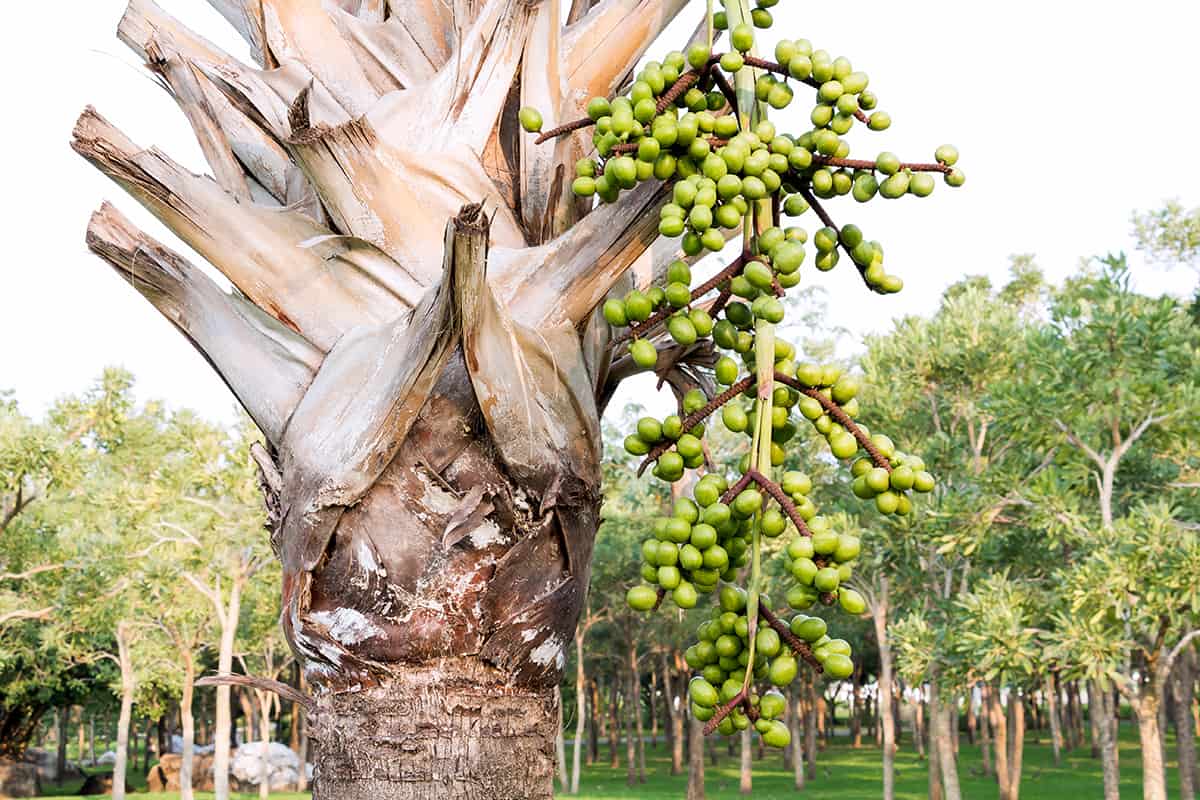
Saw Palmetto Palm trees are native to Florida, and are botanically known as Serenoa repens. The trees are dwarf palm trees and grow to maximum heights of just 10 feet. They are a surprisingly long-lived tree, with a predicted lifespan of between 500 and 700 years. These trees are widely grown as specimen trees in the landscape because they have an attractive and unusual look. The fronds are somewhat stiff in nature, and they spread out into large green fans.
The fruits of the tree form from small white flowers into berries. Before they ripen, they can be green, yellow, or orange, but when they are ripe, they will be a dark shade of blue-black. Like most fruits that grow on palm trees, the fruits of the Saw Palmetto grow in dense clusters, and the small height of the tree means they are easy to harvest.
The fruits of the Saw Palmetto palm look a lot like black olives and have a similar oil-like shine. However, despite having a sweet and appealing aroma, they have an unpleasant bitter taste, and as such, they are not cultivated for use as an edible. What is special about these fruits is their medicinal benefits.
They are widely touted as being useful in treating prostate problems in men, such as prostate enlargement and prostate cancer. The fruits are dried and ground into a fine powder and can then be added to smoothies and shakes to be consumed.
Oil Palm Fruits
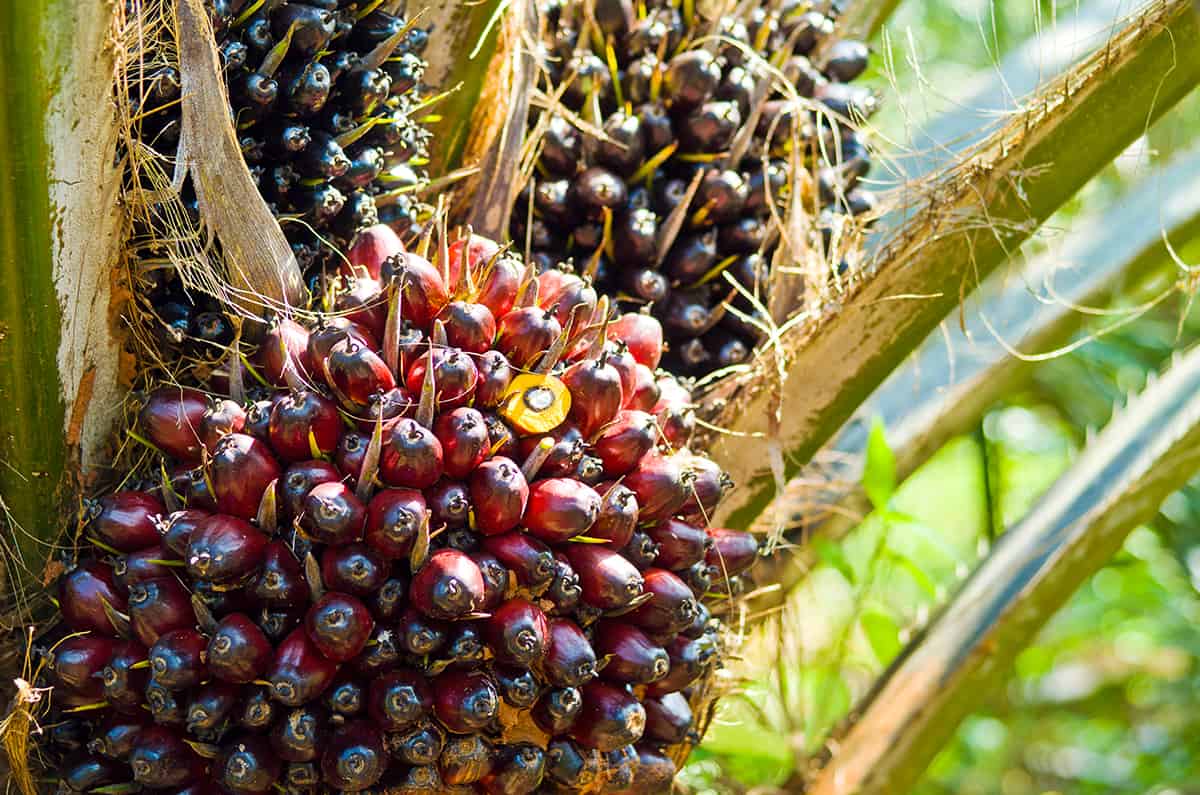
Oil palm fruits are produced on palm trees which are commonly known as Oil Palm trees, African Oil Palm, and Macaw Fat Palm, and botanically called Elaeis guineensis. As you may have guessed from the name, the fruits of this tree are used in the production of palm oil and vegetable oil.
They grow in massive clusters of large red-orange round-shaped fruits, which are very showy beneath the fronds of the tree. A single cluster can weigh up to a whopping 30kg. The fruits have an oily flesh, and they contain a seed that is also rich in oil. Both the flesh of the fruit and the seed are pressed to release the oil, and it is then predominantly used in making palm oil and vegetable oil.
The oils are then typically used in foods, as well as in the production of soaps. The oil is rich in healthy fats and antioxidants, and it is widely used across the world because of its low price. However, the mass production of palm oil from Oil Palm trees has had a very negative impact on the environment, and the industry is also heavily associated with human rights abuse. As such, many people try to limit their intake of palm oil or support products that use sustainably sourced palm oil.
Betel Nut Palm Fruits
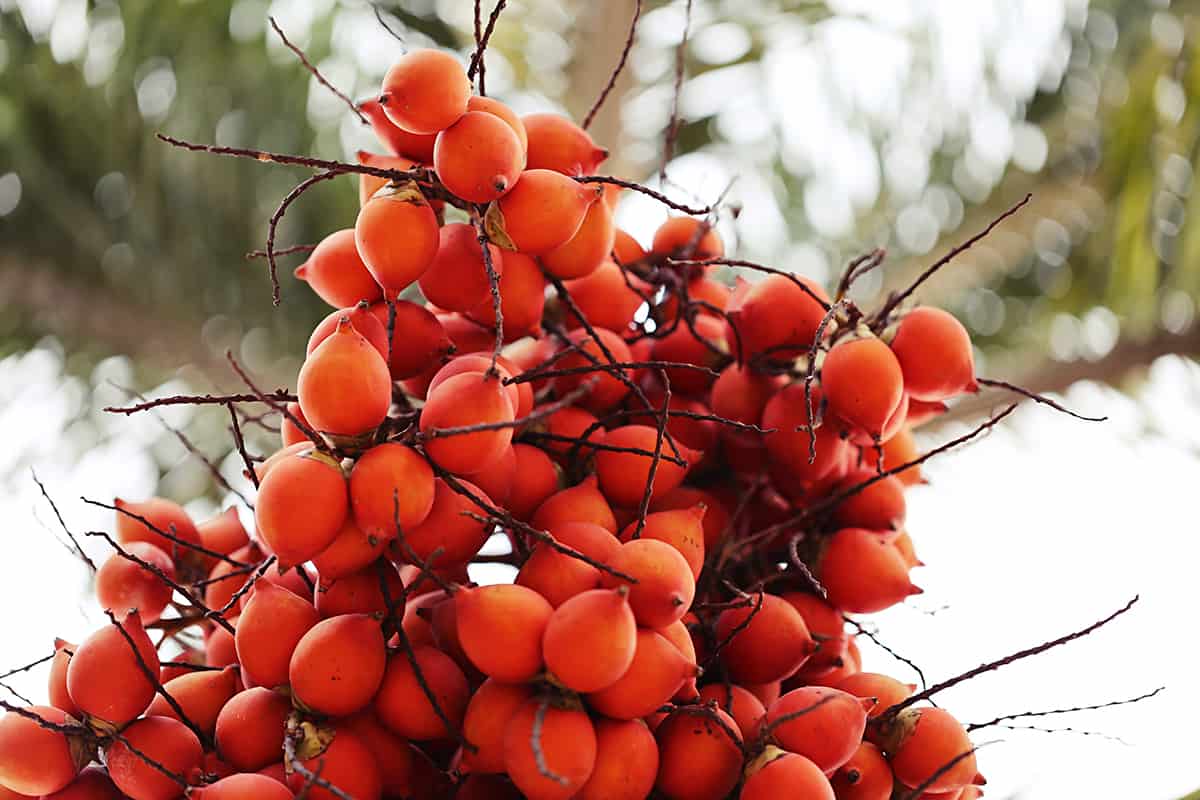
The Betel Nut Palm tree, botanically called Areca catechu, is believed to be native to the Philippines but is now widely grown across much of Asia, the Pacific, and East Africa. It produces fruits that are commonly known as areca nuts, even though they are in fact a type of drupe rather than a type of nut.
The areca nut also goes by the name of the betel nut because it is often chewed in conjunction with the leaf of the betel tree. The round fruits grow in heavy clusters and are orange when young before ripening into brown egg-shaped nuts. The trees are cultivated for their fruits, which are very popular across Asian countries.
They are used for chewing on, and they have an intoxicating and stimulating effect. The fruits contain significant levels of carcinogens, and they are directly linked to the rise in types of oral cancers. The fruits are also addictive and, in some countries, are sold with artificial additives, which can also be damaging to health.
